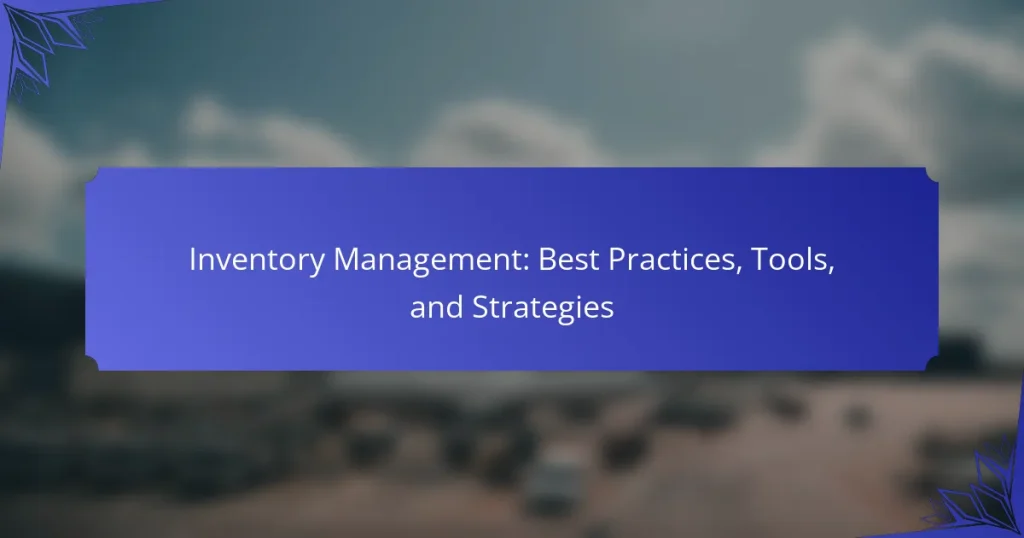Effective inventory management is crucial for businesses aiming to optimize stock levels, minimize costs, and enhance customer service. By implementing best practices and utilizing the right tools, companies can achieve greater efficiency and responsiveness to market demands. Selecting appropriate inventory management software tailored to specific needs can significantly streamline operations and improve accuracy in tracking inventory.

What Are the Best Practices for Inventory Management?
Best practices for inventory management focus on optimizing stock levels, reducing costs, and improving service levels. Implementing effective strategies can lead to increased efficiency and better alignment with customer demand.
Just-in-Time Inventory
Just-in-Time (JIT) inventory is a strategy that aims to reduce inventory carrying costs by receiving goods only as they are needed in the production process. This approach minimizes excess stock and storage costs, enhancing cash flow.
To implement JIT, businesses should establish strong relationships with suppliers to ensure timely deliveries. It is crucial to have reliable forecasting and a responsive supply chain to avoid stockouts, which can disrupt operations.
ABC Analysis
ABC analysis categorizes inventory into three groups based on their importance: A items are high-value with low frequency, B items are moderate in both value and frequency, and C items are low-value with high frequency. This method helps prioritize management efforts and resources.
Focus on A items to ensure they are always in stock, as they contribute significantly to revenue. Regularly review and adjust the categories based on changing sales patterns to maintain effectiveness.
Regular Audits
Conducting regular audits is essential for maintaining accurate inventory records and identifying discrepancies. Audits can be done through cycle counting, where a portion of the inventory is counted on a rotating schedule, or full physical counts at set intervals.
Establish a routine audit schedule and use technology such as barcode scanners to streamline the process. Addressing discrepancies promptly can prevent larger issues and improve overall inventory accuracy.
Demand Forecasting
Demand forecasting involves predicting future customer demand to optimize inventory levels. Accurate forecasts help businesses maintain the right amount of stock, reducing both overstock and stockouts.
Utilize historical sales data, market trends, and seasonal variations to inform forecasts. Employ statistical methods or software tools to enhance accuracy, and adjust forecasts regularly based on real-time sales data.
Supplier Relationship Management
Effective supplier relationship management is critical for ensuring a reliable supply chain. Building strong partnerships with suppliers can lead to better pricing, improved quality, and more flexible delivery options.
Communicate regularly with suppliers to discuss performance and expectations. Consider diversifying suppliers to mitigate risks and ensure continuity in case of disruptions, such as natural disasters or economic shifts.

Which Tools Enhance Inventory Management?
Several tools can significantly enhance inventory management by automating processes, improving accuracy, and providing real-time data. Selecting the right tool depends on your business size, industry, and specific needs.
TradeGecko
TradeGecko, now known as QuickBooks Commerce, is designed for small to medium-sized businesses looking to streamline their inventory processes. It offers features like order management, inventory tracking, and integration with e-commerce platforms.
Consider using TradeGecko if you need a user-friendly interface and seamless integration with accounting software. It allows for real-time inventory updates, which can help prevent stockouts and overstock situations.
NetSuite
NetSuite is a comprehensive cloud-based ERP solution that includes robust inventory management capabilities. It is suitable for larger businesses that require advanced features such as demand planning, supply chain management, and multi-location inventory tracking.
When using NetSuite, take advantage of its customizable dashboards and reporting tools to gain insights into inventory performance. This can help optimize stock levels and reduce carrying costs.
Zoho Inventory
Zoho Inventory is an affordable option for small businesses looking to manage their inventory efficiently. It provides features like order fulfillment, stock tracking, and integration with various sales channels.
Utilize Zoho Inventory if you want a cost-effective solution with essential functionalities. Its user-friendly design makes it easy to track inventory across multiple locations and automate reordering processes.
Fishbowl Inventory
Fishbowl Inventory is a powerful inventory management tool that integrates with QuickBooks and offers extensive features for manufacturing and wholesale businesses. It focuses on inventory control, order management, and manufacturing processes.
Consider Fishbowl if you need advanced inventory tracking and manufacturing capabilities. Its ability to handle complex inventory needs makes it suitable for businesses with diverse product lines and high transaction volumes.

How to Choose the Right Inventory Management Software?
Selecting the right inventory management software involves understanding your specific business needs, ensuring compatibility with existing systems, and prioritizing user-friendliness. A well-chosen system can streamline operations, reduce costs, and improve accuracy in tracking inventory levels.
Assess Business Needs
Begin by identifying the unique requirements of your business. Consider factors such as the size of your inventory, the complexity of your supply chain, and the specific features you need, such as real-time tracking or automated reordering. This assessment will help narrow down options that align with your operational goals.
For example, a small retail store may prioritize basic tracking features, while a large manufacturer might need advanced analytics and integration with other systems. Make a list of must-have features versus nice-to-have ones to guide your decision-making process.
Evaluate Integration Capabilities
Check how well the inventory management software integrates with your existing systems, such as accounting software, e-commerce platforms, or ERP systems. Seamless integration can save time and reduce errors by ensuring data flows smoothly between applications.
Look for software that offers APIs or built-in connectors to popular platforms. If you use specific tools like Shopify or QuickBooks, ensure the inventory solution can easily connect to them to maintain consistency across your operations.
Consider User Experience
User experience is crucial for ensuring that your team can effectively use the software without extensive training. Look for intuitive interfaces and easy navigation to minimize the learning curve. A user-friendly design can enhance productivity and reduce frustration among staff.
Consider conducting trials or demos with your team to gather feedback on usability. This hands-on approach can help you identify potential issues before making a commitment.
Check Scalability Options
As your business grows, your inventory management needs may change. Choose software that can scale with your operations, whether that means handling increased inventory volume or adding new features as needed. Scalability ensures that you won’t outgrow your system too quickly.
Inquire about pricing structures for additional features or higher usage tiers. Some software solutions offer flexible plans that allow you to upgrade as your business expands, which can be more cost-effective in the long run.

What Are the Key Metrics for Inventory Management?
The key metrics for inventory management include various measurements that help businesses assess their inventory efficiency and effectiveness. Understanding these metrics allows companies to optimize stock levels, reduce costs, and improve customer satisfaction.
Inventory Turnover Ratio
The inventory turnover ratio measures how often a company sells and replaces its stock within a specific period, typically a year. A higher ratio indicates efficient inventory management, while a lower ratio may suggest overstocking or weak sales. Generally, a turnover ratio of 5 to 10 is considered healthy, but this can vary by industry.
To calculate this ratio, divide the cost of goods sold (COGS) by the average inventory for the period. For example, if COGS is $500,000 and average inventory is $100,000, the turnover ratio would be 5. Regularly monitoring this metric helps identify trends and adjust purchasing strategies accordingly.
Carrying Cost of Inventory
The carrying cost of inventory encompasses all costs associated with holding inventory over a specific period. This includes storage costs, insurance, depreciation, and opportunity costs. Typically, carrying costs can range from 20% to 30% of the total inventory value annually.
To manage these costs effectively, businesses should regularly review inventory levels and implement just-in-time (JIT) practices to minimize excess stock. Avoiding overstocking can significantly reduce carrying costs and improve cash flow.
Stockout Rate
The stockout rate indicates the frequency at which items are out of stock, which can lead to lost sales and dissatisfied customers. A low stockout rate is crucial for maintaining customer loyalty and ensuring smooth operations. Ideally, businesses should aim for a stockout rate of less than 5%.
To reduce stockouts, companies should analyze sales trends and adjust reorder points accordingly. Implementing automated inventory management systems can also help track stock levels in real-time and trigger reorders when necessary.
Order Cycle Time
Order cycle time measures the total time taken from when an order is placed until it is fulfilled. This metric is critical for assessing the efficiency of the supply chain and inventory management processes. A shorter order cycle time typically leads to higher customer satisfaction and better inventory turnover.
To improve order cycle time, businesses should streamline their ordering processes, enhance communication with suppliers, and utilize technology for better tracking. Regularly reviewing and optimizing these processes can lead to significant improvements in overall efficiency.

How to Implement Inventory Management Strategies?
Implementing effective inventory management strategies involves assessing your current processes, selecting the right tools, and continuously optimizing your approach. Key steps include setting clear goals, utilizing technology for tracking, and regularly reviewing inventory levels to meet demand efficiently.
Assess Your Current Inventory Management Process
Begin by analyzing your existing inventory management process to identify strengths and weaknesses. Look for inefficiencies, such as overstocking or stockouts, and evaluate how well your current system meets customer demand. This assessment will guide you in making informed decisions about necessary changes.
Consider using metrics like inventory turnover ratio and carrying costs to quantify performance. These metrics help in understanding how quickly inventory is sold and the costs associated with holding stock, which are crucial for optimizing your strategy.
Choose the Right Inventory Management Tools
Selecting the appropriate inventory management tools is essential for streamlining operations. Options range from simple spreadsheets to advanced software solutions that offer real-time tracking, automated reordering, and analytics. Evaluate your business size, budget, and specific needs when choosing a tool.
Popular tools include cloud-based systems like TradeGecko or Fishbowl, which provide scalability and integration with other business applications. Ensure the tool you choose can adapt to your growth and changing inventory needs.
Implement Inventory Tracking Techniques
Effective inventory tracking techniques are vital for maintaining optimal stock levels. Methods such as FIFO (First In, First Out) and LIFO (Last In, First Out) help manage stock rotation and ensure older items are sold first. Choose a method that aligns with your product type and business model.
Utilizing barcode scanning or RFID technology can significantly enhance accuracy in tracking inventory. These technologies reduce human error and allow for quicker stock audits, ensuring you always have a clear picture of your inventory status.
Regularly Review and Optimize Inventory Levels
Regular reviews of your inventory levels are crucial for adapting to market changes and consumer demand. Set a schedule for inventory audits, whether monthly or quarterly, to assess stock levels and adjust reorder points accordingly. This practice helps prevent overstocking and stockouts.
Use historical sales data and market trends to forecast demand accurately. This information allows you to make informed decisions about how much inventory to keep on hand, ensuring that you meet customer needs without tying up excessive capital in stock.


